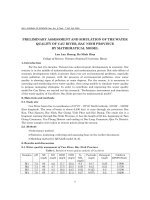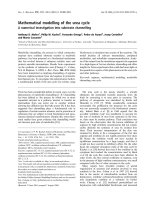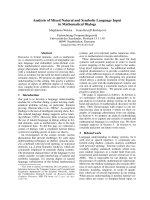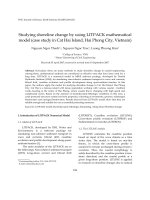MATHEMATICAL PUZZLE SESSIONS
Bạn đang xem bản rút gọn của tài liệu. Xem và tải ngay bản đầy đủ của tài liệu tại đây (256.97 KB, 6 trang )
<span class="text_page_counter">Trang 1</span><div class="page_container" data-page="1">
Pascal’s Triangle is an infinite triangular array of numbers beginning with a 1 at the top.Pascal’s Triangle can be constructed starting with just the 1 on the top by following one easyrule: suppose you are standing in the triangle and would like to know which number to put inthe position you are standing on. Look up and to the left, then up and to the right, sum thenumbers and you have the entry of Pascal’s Triangle corresponding to your current location.Rows 0 thru 12 of Pascal’s Triangle look like
11 1
Notice if there is not a number either on the left or the right in the row above an entry then themissing number is replaced with a zero.
1
</div><span class="text_page_counter">Trang 2</span><div class="page_container" data-page="2">Patterns in Pascal’s Triangle
Although it is quite easy to construct Pascal’s Triangle, it contains many patterns, some ing and some complex.
In the mathematical field of combinatorics, a subset of k elements from a larger set of n elementsis called a combination. The number of combinations of size k denoted C(n, k) and can be readas: how many different ways are there to choose k objects from a pool of n objects? Dependingon how you solved the featured puzzle, you may have noticed the number of rook paths to eachcell on the lower left triangle of the chess board gives rows 0 through 7 of Pascal’s Triangle. Thisis because the entry in the k<sup>th</sup> column of row n of Pascal’s Triangle is C(n, k).
The Fibonacci Numbers
Remember, the Fibonacci sequence is given by the recursive definition F<sub>0</sub> = F<sub>1</sub> = 1 andF<sub>n</sub> = F<sub>n−1</sub> + F<sub>n−2</sub> for n ≥ 2. This sequence can be found in Pascal’s Triangle by drawingdiagonal lines through the numbers of the triangle, starting with the 1’s in the first column ofeach row, and adding the numbers the diagonal passes through.
Try it yourself:
11 1
</div><span class="text_page_counter">Trang 3</span><div class="page_container" data-page="3">Rectangular Sums
To see this next pattern it is best to redraw the triangle in yet another way. Write the diagonalsof the triangle as columns. Now, pick any number in the triangle, the first 15, say, and draw asquare around it. Starting from the upper left corner of the square, draw a line up and one tothe left. It should look something like this:
1 1 1 1 1 1 11
2 3 4 5 6 73 6 10 15 21 284 10 20 35 56 845 15 35 70 126 210
1 1 1 1 1 1 11
2 3 4 5 6 73 6 10 15 21 284 10 20 35 56 845 15 35 70 126 210
The sum of the numbers in the rectangular region is 14. Try this starting with a square aroundthe 20, the 56 and any other number you like.
Notice anything?
What is the relationshipbetween the sum and the number you drew a square around?Congruent Numbers
If the integers n and m have the same remainder when divided by a, n and m are called congruentmodulo a. For example, 7, 34 and 127 are all congruent to 1 modulo 3, and 6 is congruent to 0modulo 3 since there is no remainder when 6 is divided by 3. The parity of a number can alsobe described in these terms: n is even if it is congruent to 0 modulo 2 and odd if it is congruentto 1 modulo 2.
Check this out!
In the figure below all the numbers in Pascal’s Triangle which are congruentto 1 modulo 2 have been shaded.Does it look familiar? This is a fractal called Sierpinski’s Triangle, which was featured in a puzzlelast month.
You try. On the back page there is a triangle figure with each row drawn as a tessellationof equilateral triangles. Fill in the triangle by summing the two numbers above each location.Then, choose a new congruency class, fill in all of the triangles in that class and see what kindof pattern you get.
</div><span class="text_page_counter">Trang 4</span><div class="page_container" data-page="4">Informally, a fractal is a set or geometric shape which posses self-similarity. You can see thatthe Sierpinski Triangle above has a self-similar pattern; if we zoom in, the pattern of smallertriangles appear the same as when we look at the entire triangle. The Cantor set, describedbelow, and golden rectangle also have nice self-similarity patterns. All of these fractals can bedefined iteratively. (Not all fractals are formed by an iterative process, but we will focus onthose here.) Sierpinski’s Triangle is constructed by beginning with a triangle and connecting themidpoints of each edge to make a new triangle. This triangle is then removed, and the sameprocesses is carried out in each of the three remaining triangles and so on. The Cantors set, orcomb, is similar to Sierpinski’s triangle in that at each step a deletion occurs: a line of unit lengthis divided into thirds and the middle third is deleted. Each of the two remaining line segmentsis divided into thirds and the middle third of each is deleted and so on. The construction of thegolden rectangle was described in Golden Ratio hand out (available online).
The ratio of the sides of each of the rectangles isthe golden ratio.
The Cantor comb fractal.
Iterative fractals can be described by L-systems, which consist of generators and rules of how to erate these generators. For example, suppose we have generators a and b and rules a → ab, b → a,where an arrow means that whatever is on the left side of the arrow will be replaced with whatis on the right side. If we specify that the patter will start with b, the first iteration gives an a,so the second iteration yields ab. A further iteration gives aba since, according to the rules, thea in the result of the second iteration is replaced with ab and the b is replaced by a. This canalso be drawn in a tree form:
it-Carry out a few more iterations according to the ment rules. Do you notice anything about the numberof letters in each row of the tree?
</div><span class="text_page_counter">Trang 5</span><div class="page_container" data-page="5">replace-The generators above are variables because they are replaced each iteration according to therule. Constants can also be introduced. A generator is constant if it is just replaced with itself, sowe can think of it as staying put while the variables around it change after an iteration. Considera new system with variables F , constants + and −, and one rule F → F + F − F − F + F . Here,the variable means draw a line forward, + means turn 60<sup>◦</sup> counter-clockwise and − means turn60<sup>◦</sup> clockwise. Starting with an F , one iteration yields F + F − F − F + F and a second givesF +F −F −F +F + F +F −F −F +F - F +F −F −F +F - F +F −F −F +F + F +F −F −F +F.The first two iterations look like:
This is a fractal called the Koch curve. A Koch snowflake can be made by starting with a triangleand applying the rule to each edge at each iteration. The one shown on the right is the resultof three iterations. Changing the angle assigned to + and − will produce variants of the abovesnowflake. Other fractals made by using an L-system are shown below.
By the way, the“L” in L-system is for Lindenmayer. Aristid Lindenmayer was a biologist whodeveloped what are now called L-systems to model plant growth. (It should make sense nowwhy you found the pattern you did in the number of letters in the rows of the first L-systemexample.)
Make your own!
Many fractals can be generated this way. It is also fun to make up yourown set of generators and rules and see what the result looks like! There are links to appletsthat allow you to do this on the last page. Have fun!</div><span class="text_page_counter">Trang 6</span><div class="page_container" data-page="6">There is an applet at www.shodor.org/interactive/activities/ which shades in multiples of anynumber you choose.
Links to more information
(Also at: www.math.cornell.edu/ araymer/Puzzle/PuzzleNights.html)Counting: & Pascal’s Triangle: in Pascal’s Triangle: Arithmetic: generated fractals: Applets:









